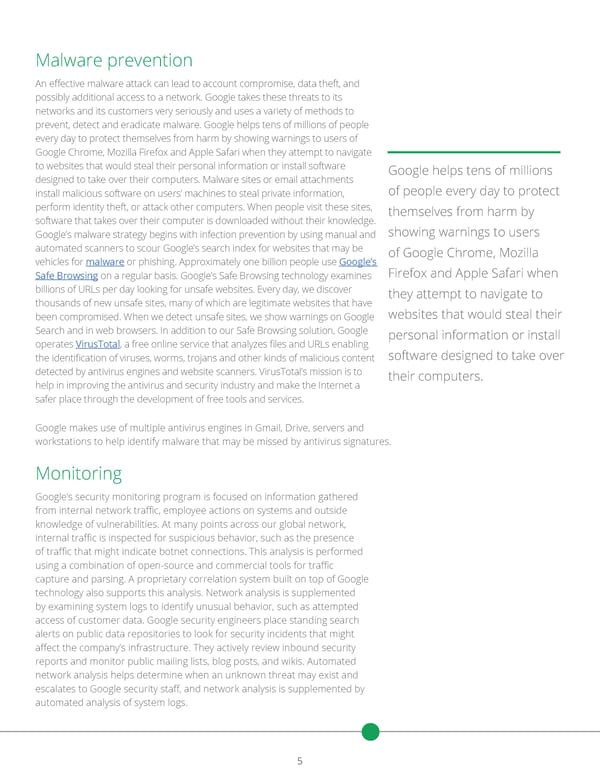Malware prevention An—efective—malware—attack—can—lead—to—account—compromise,—data—theft,—and possibly additional access to a network. Google takes these threats to its networks and its customers very seriously and uses a variety of methods to prevent, detect and eradicate malware. Google helps tens of millions of people every day to protect themselves from harm by showing warnings to users of Google Chrome, Mozilla Firefox and Apple Safari when they attempt to navigate to websites that would steal their personal information or install softwareGoogle helps tens of millions designed to take over their computers. Malware sites or email attachmentsof people every day to protect install malicious software on users’ machines to steal private information, perform identity theft, or attack other computers. When people visit these sites,themselves from harm by software that takes over their computer is downloaded without their knowledge.showing warnings to users Google’s malware strategy begins with infection prevention by using manual and automated scanners to scour Google’s search index for websites that may beof Google Chrome, Mozilla vehicles for malware or phishing. Approximately one billion people use Google’s Firefox and Apple Safari when Safe Browsing on a regular basis. Google’s Safe Browsing technology examines billions of URLs per day looking for unsafe websites. Every day, we discoverthey attempt to navigate to thousands of new unsafe sites, many of which are legitimate websites that havewebsites that would steal their been compromised. When we detect unsafe sites, we show warnings on Google Search and in web browsers. In addition to our Safe Browsing solution, Googlepersonal information or install operates VirusTotal ,—a—free—online—service—that—analyzes—iles—and—URLs—enabling—software designed to take over the—identiication—of—viruses,—worms,—trojans—and—other—kinds—of—malicious—content— detected by antivirus engines and website scanners. VirusTotal’s mission is totheir computers. help in improving the antivirus and security industry and make the Internet a safer place through the development of free tools and services. Google makes use of multiple antivirus engines in Gmail, Drive, servers and workstations to help identify malware that may be missed by antivirus signatures. Monitoring Google’s security monitoring program is focused on information gathered from—internal—network—traic,—employee—actions—on—systems—and—outside— knowledge of vulnerabilities. At many points across our global network, internal—traic—is—inspected—for—suspicious—behavior,—such—as—the—presence— of—traic—that—might—indicate—botnet—connections.—This—analysis—is—performed— using—a—combination—of—open-source—and—commercial—tools—for—traic— capture and parsing. A proprietary correlation system built on top of Google technology also supports this analysis. Network analysis is supplemented by examining system logs to identify unusual behavior, such as attempted access of customer data. Google security engineers place standing search alerts on public data repositories to look for security incidents that might afect—the—company’s—infrastructure.—They—actively—review—inbound—security— reports and monitor public mailing lists, blog posts, and wikis. Automated network analysis helps determine when an unknown threat may exist and escalates—to—Google—security—staf,—and—network—analysis—is—supplemented—by— automated analysis of system logs. 5
 Google Cloud Security and Compliance Whitepaper Page 8 Page 10
Google Cloud Security and Compliance Whitepaper Page 8 Page 10.png)